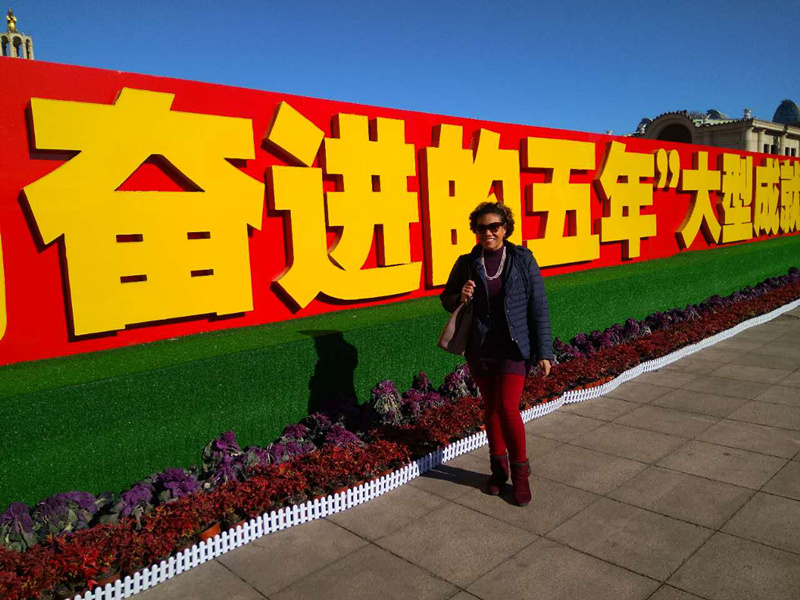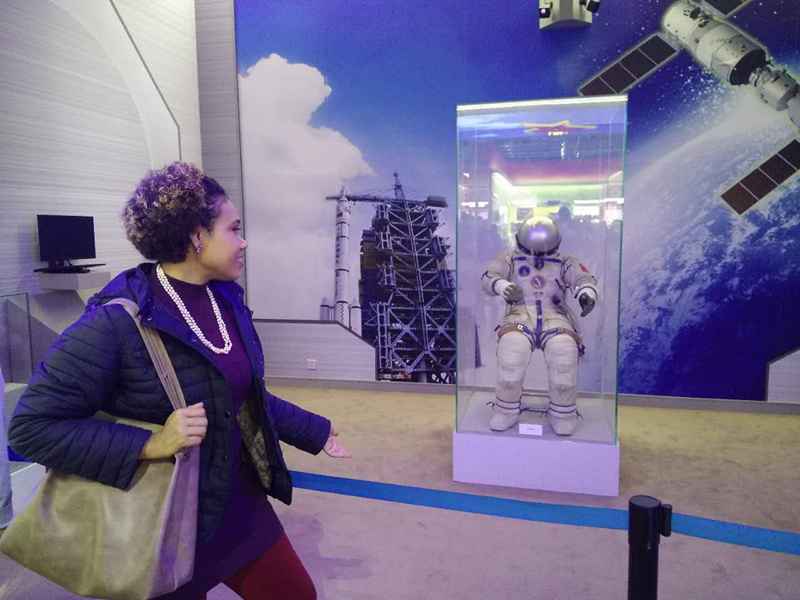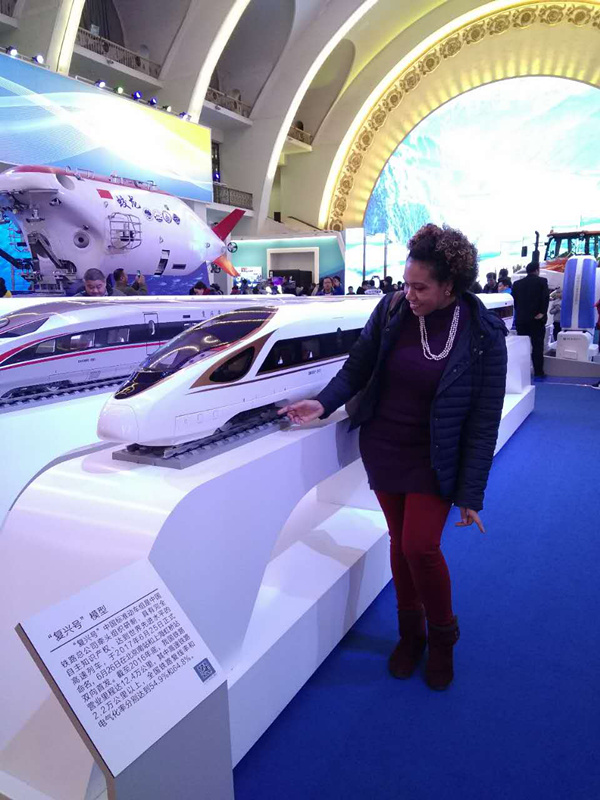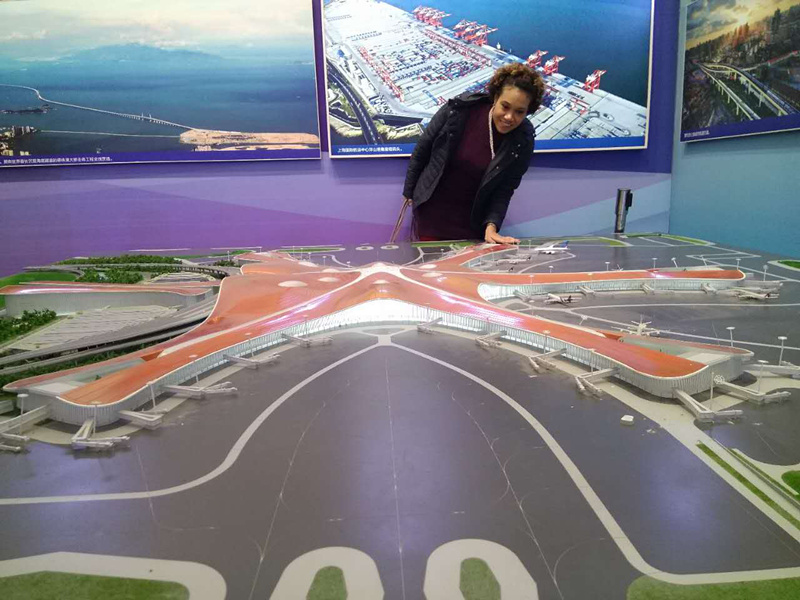By Vicki Cann, PhD Candidate at Communication University of China
Beijing is holding an exhibition that sought to document China's numerous achievements over the past five years in the Beijing Exhibition Center. The display highlighted aspects of China's extensive military capacity, space exploration, infrastructure, agricultural, medical and other facets of its overall development while also alluding to the country's auspicious future.

(The writer visits the exhibition highlighting China's achievements in the past 5 years at Beijing Exhibition Center. Photo by Simon Matingwina)
Unless one is hiding under a rock, most are aware that China is making great strides on the international stage. As foreigners living in Beijing, how many times have we really stopped to think about how fast China is changing right before our very eyes? The exciting part is that many of us are incredibly privileged to be first hand witnesses of China's rapidly evolving environment.
The 2017 exhibition has encapsulated the essence of the country's phenomenal triumphs over the past five years; I am fortunate to have been living in China for two of those remarkable years. As I reflect on past achievements I am particularly impressed by the country's advances in space exploration, infrastructure development especially with regards to transportation, as well as its significant developments in the medical field.
China ahead in the Space Race
In recent years it is not difficult to surmise that China is now making substantial advances in space exploration. Upon entering the massive exhibition hall, one is greeted by a rendition of China's Chang'e 3 Spacecraft and its Moon Rover fondly dubbed Yutu or Jade Rabbit. The spacecraft landed on the moon's surface on Dec. 14, 2013. This historic feat is the most recent soft landing on the moon as the last recorded landing was a former Soviet Union vessel in 1976, which was preceded by NASA's spacecraft in 1972.

(The writer visits the exhibition highlighting China’s achievements in the past 5 years at Beijing Exhibition Center. Photo by Simon Matingwina)
Based on the data from the rover's expedition, it was revealed that the composition of the terrain explored was notably different from the areas visited by the former Soviet Union's Luna mission and NASA's Apollo mission. Ground-penetrating radar measurements taken by Yutu revealed at least nine subsurface layers beneath its landing site, indicating that the moon's geological history is more complex than previously thought.
In spite of Yutu's grand debut, China hasn't stopped there as plans remain afoot to launch a rover onto Mars at around 2020, to study the Red Planet's soil, atmosphere, environment, and look for traces of water.
2020 will be a phenomenal year for China's ambitious space program as the country gears up to launch its first reusable spacecraft. The vessel is being completed by the China Aerospace Science and Technology Corporation (CASC) and is designed to be more cost effective, easier to maintain and seeks to increase the frequency of earth-to-orbit launches. The nation's leaders are also determined to establish an active space station within the next few years.
In September, in an interview with China's official Xinhua News Agency, the Director of the United Nations Office for Outer Space Affairs (UNOOSA), Simonetta Di Pippo, commended China for being an active member of the United Nations Committee on the Peaceful Uses of Outer Space as well as the country's solid contributions, technical expertise and its new initiatives and ideas. One of China's most recent programs is China's extension of the Belt and Road Initiative in regards to outer space. Di Pippo said the UNOOSA is in talks with the Chinese Government on how to become more involved with China's Belt and Road Space plans, which illustrate the country's clear intentions to continue its space exploration drive.
China's Contribution to 2014 Ebola Crises
Meanwhile, even more changes are happening back on earth with China pulling more than its weight in the medical field. During the exhibition a section was dedicated to showcasing boxes of the Adenovirus Type 5 Based Ebola Virus Vaccine. Well, chills went down my spine as I thought about the lives lost on account of the disease, but seeing the display brought a feeling of renewed hope in China's medical contributions.
In recent years, the outbreak of the fatal Ebola disease has threatened the lives of more than 4 thousands and has spread from the African continent with reported cases as far as the United States. The disease was first discovered in 1976 near to the Ebola River in the Democratic Republic of the Congo (DRC). Sporadic outbreaks have occurred across the continent over the last forty years. Five Ebola virus species have been identified, four of which have been deadly for humans causing a 90 percent death rate. In response to the 2014 outbreak in West Africa, China had contributed approx. USD 5 million worth of equipment including protective gear and other related items.
However, China's response did not stop there, as the country's medical experts began developing a vaccine on the Ebola virus strain, which made its fatal debut in the 2014 West African outbreak. Until this time, the tested Ebola vaccines were all based on the strain that first appeared in 1976 in the DRC.
China's vaccine is made in the form of a freeze-dried powder, a method that ensures the vaccine will remain stable in very hot temperatures of up to 37 degrees Celsius for a minimum of two weeks. This development suggests that the vaccine is appropriate for tropical climates and its extended 'shelf life' will certainly promote its production on a large scale. The vaccine underwent overseas clinical trials in Sierra Leone which proved the effectiveness and safety of China's independently developed Ebola vaccine.
China's Advanced Transportation System
While many of us may never traverse further than this planet and are fortunate enough not to be exposed to the Ebola virus, China's transport system affects the lives of billions of people and remains an area the Government stands committed to improving.
The exhibition had several segments where replicas of China's world-renowned Fuxing bullet trains, Jiaolong underwater submarines, and a beautifully designed rendition of Beijing’s new airport were all on display.
The starfish shaped design is reported to be the largest airport in the world measuring 1,144 meters in length from east to west and 996 meters from north to south. It will replace the current record holder, the King Fahd International Airport in Saudi Arabia, which was formerly the world’s largest airport.
With its upper floor devoted to international flights and its lower floors for domestic, the airport boasts 78 gates across the two floors. The new airport is built to accommodate 72 million travelers a year; combined with the capital’s current airport, both Beijing based facilities are expected to witness over 150 million passengers a year.


(The writer visits the exhibition highlighting China’s achievements in the past 5 years at Beijing Exhibition Center. Photo by Simon Matingwina)
While this is just a small fraction of the exhibition's extensive coverage of the country's milestones, the achievements allude to the fact that China is not slowing down anytime soon and we can expect greater and grander highlights in the future.
( The opinions expressed here do not necessarily reflect the opinions of Panview or CCTV.com. )

Panview offers a new window of understanding the world as well as China through the views, opinions, and analysis of experts. We also welcome outside submissions, so feel free to send in your own editorials to "globalopinion@vip.cntv.cn" for consideration.
















